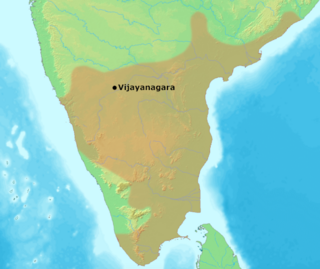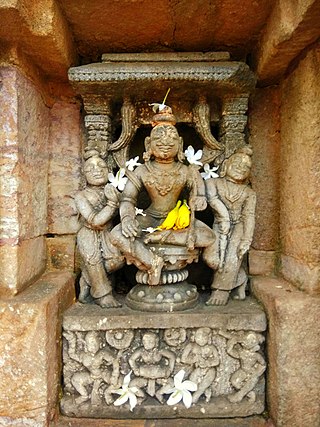
The Vijayanagara Empire originally known as Karnataka Empire, was a late medieval Hindu empire that ruled much of southern India. It was established in 1336 by the brothers Harihara I and Bukka Raya I of the Sangama dynasty, members of a pastoralist cowherd community that claimed Yadava lineage.

Krishnadevaraya was an emperor of the Vijayanagara Empire reigning from 1509 to 1529. He was the third monarch of the Tuluva dynasty, and is considered to be one of the greatest rulers in Indian history. He ruled the largest empire in India after the fall of the Islamic Delhi Sultanate. Presiding over the empire at its zenith, he is regarded as an icon by many Indians. Krishnadevaraya earned the titles Andhra Bhoja, Karnatakaratna Simhasanadeeshwara, Yavana Rajya Pratistapanacharya, Kannada Rajya Rama Ramana, Gaubrahmana Pratipalaka and Mooru Rayara Ganda. He became the dominant ruler of the peninsula by defeating the sultans of Bijapur, Golconda, the Bahmani Sultanate and the Gajapatis of Odisha, and was one of the most powerful Hindu rulers in India.

The Kakatiya dynasty was a Telugu dynasty that ruled most of eastern Deccan region in present-day India between 12th and 14th centuries. Their territory comprised much of the present day Telangana and Andhra Pradesh, and parts of eastern Karnataka, northern Tamil Nadu, and southern Odisha. Their capital was Orugallu, now known as Warangal.
Reddy is a Hindu caste predominantly found in the states of Andhra Pradesh and Telangana in South India. They are classified as a forward caste.
The Reddi kingdom or Kondavidu Reddi kingdom was a kingdom established and ruled by Prolaya Vema Reddi from 1325 to 1448 CE in southern India. Most of the region that was ruled by the kingdom is now part of modern-day Rayalaseema, coastal and central Andhra Pradesh.

Ranga Reddy district is a district in the Indian state of Telangana. The district headquarters is located at Kongara Kalan Village, Ibrahimpatnam Mandal,. The district was named after the former deputy chief minister of the United Andhra Pradesh, K. V. Ranga Reddy. The district shares boundaries with Nalgonda, Yadadri Bhuvanagiri, Hyderabad, Medchal–Malkajgiri, Nagarkurnool, Mahabubnagar, Sangareddy and Vikarabad districts.

The Musunuri Nayakas were a ruling family of 14th-century South India who were briefly significant in the region of Telangana and Andhra Pradesh. Musunuri Kapaya Nayaka is said to have taken a leadership role among the Andhra chieftains and driven out the Delhi Sultanate from Warangal. But his rise was soon challenged by the Bahmani Sultanate and he was defeated along with the Vijayanagar in the Bahmani–Vijayanagar War. The Recherla Nayakas wrested power from him in 1368.
Pemmasani Kamma Nayaks were a ruling clan in the south Indian state of Andhra Pradesh. They came into prominence during Vijayanagara Empire. After the Battle of Talikota in 1565 AD, the collapse of Vijayanagara Empire led to the emergence of Pemmasani Nayakas in the Rayalaseema region. They belonged to the Kamma social group.
Tuluva Narasa Nayaka was an Indian general and later an imperial regent who founded the Tuluva dynasty of the Vijayanagara Empire. He was the father of the emperors Viranarasimha Raya, Krishnadevaraya and Achyuta Deva Raya.

Panagal, also referred to as Panagallu or Panugallu, is a historic town located 4 km northeast from Nalgonda city in Telangana, India.

The recorded history of Andhra Pradesh, one of the 28 states of 21st-century India, begins in the Vedic period. It is mentioned in Sanskrit epics such as the Aitareya Brahmana. Its sixth-century BCE incarnation Assaka lay between the Godavari and Krishna Rivers, one of sixteen mahajanapadas. The Satavahanas succeeded them, built Amaravati, and reached a zenith under Gautamiputra Satakarni.
Shitab Khan, also spelled Chitapu Khan, was born Sitapathi Raju in the Telangana, India. He joined as a foot soldier in the army of Humayun Shah, the Turko-Persian Bahmani Sultan, and rose up the ranks to acquire senior captaincy, his own jagir and the title 'Shitab Khan'. He always used the title in his inscriptions but never actually converted to Islam.

The Nayakas of Kalahasti were a line of rulers of Kalahasti and Vandavasi principalities. Members of the group include Damarla Chennapa Nayaka, after whom the city of Chennai is named. The Kalahasti Nayaks had their origins in the Velama warrior clans of present-day Andhra Pradesh. These Nayakas served as vassals of the late Vijayanagara Empire, then held by the Aravidu Dynasty and headquartered at Chandragiri and Vellore.

Kapilendra Deva was the founder of the Suryavamsa Gajapati Empire that ruled parts of eastern and southern India with the present-day Odisha as the center of the empire. He ascended to the throne after staging a military coup against the preceding and the last ruler from the Eastern Ganga dynasty, Bhanu Deva IV. He is also referred to as Kapilendra Routray. Kapilendra claimed descent from the Surya Vamsha of the Mahābhārata and was conferred the regnal title Shri Shri ...(108 times) Gajapati Gaudeshwara NabaKoti Karnata Kalabargeswara i.e. the Lord of Bengal (Gauda), the lord of the Karnataka region or Vijayanagara, the Lord of Kalaburagi and of nine crore subjects.
Khilla Ghanpur is a historic place equidistant, 25 km, from Mahabubnagar and Wanaparthy towns of Telangana state, India. It is 111 kilometers away from Hyderabad city.

Recherla Nayakas were an Andhra dynasty that wrested power from the Musunuri Nayakas and became the dominant power in the Telangana region during the late 14th century and early 15th century. They were based at Rachakonda, southeast of Golconda, the border with the Bahmani sultanate during this period, and built a second base at Devarakonda.

Vira Pratapa Purushottama Deva was the second Gajapati emperor of Odisha who ruled from 1467 to 1497 C.E. He was the second ruler from the Suryavamsa Gajapati Empire. His father Gajapati Kapilendra Deva Routaraya chose him as his heir to rule the Gajapati Empire at the banks of river Krishna where he breathed his last. This decision infuriated his elder brother Hamvira Deva who was a battle hardened and successful warrior fulfilling the task of conquering the southern territories and expeditions against the Vijayanagara Empire as wished by his father.

Prataparudra Deva was the third Gajapati emperor of Odisha from the Suryavamsa Gajapati Empire founded by his grandfather Kapilendra Deva. He reigned from 1497 to 1540 CE. Besides being a monarch, he was a devout Vaishnava and adherent of the famous saint, Sri Chaitanya who arrived in Odisha during his reign. His life was extremely occupied with overwhelming military campaigns in defense of his inherited territory from three frontal invasions by the enemy states Vijayanagar, Hussain Shahi dynasty of Bengal and Turko-Persian Qutb Shahi dynasty of Golconda. He lost large portions of his territory to the neighboring enemy states initiating the dissolution of Odisha's military hegemony and imperial status that continued for nearly a period of 600 years before him.
Hamvira Deva was an Odia prince of the Gajapati Empire in India and Gajapati ruler for a brief period. He was the eldest son of Kapilendra Deva, founder of the Gajapati Empire. He played a vital role in the military expansion of the Gajapati Empire but was bypassed in the succession order in favour of his younger half-brother Purushottama Deva.

The Bahmani invasion of Orissa refers to a series of historical events in the 15th century, marked by conflicts and diplomatic maneuvers between the Gajapati Empire and the Bahmani Sultanate. In 1475, a rebel officer of Bahmani named Bhimraj, revolted at Kondavidu, a Bahmani territory, prompting a complex alliance between Gajapatis and chiefs of Telangana and Jajnagar. Tensions escalated further in 1478 when Muhammad Shah III invaded Orissa, and Purushottama Dev, alarmed by the invasion, offered homage, disarming and presenting gifts. The Sultan accepted the homage, confirming Purushottam as the ruler of his patrimony.














